The mighty Aiviq; more bridge details please
When most of us were enjoying the holiday quite the sea drama was playing out off Kodiak, Alaska. Last Friday the mighty 360-foot icebreaking anchor-handling tug supply vessel Aiviq (above) “experienced multiple engine failures” while towing the unusual conical drill ship Kulluk in 20-foot seas. Assisted by several large tugs and especially U.S. Coast Guard cutters and helicopters, the Aiviq eventually got her fuel issues solved and by Monday the Kulluk was back under tow, though without a crew and in even worse weather. And then the story turned again: The Aiviq’s tow line parted, the CG ordered the tug Alert to drop hers for the crew’s safety, and by New Year champagne time the Kulluk was hard aground being pounded by 30-foot waves…
This story is being well covered at gCaptain.com, and as a Coast Guard spokesman said, “”We are now entering into the salvage and possible spill-response phase of this event.” I’ll also note that U.S. Rep. Ed Markey added, “Oil companies keep saying they can conquer the Arctic, but the Arctic keeps disagreeing with the oil companies.” I certainly hope the salvage operation goes well, and also that there will be some good reporting on what went on aboard these vessels during this challenging time. But I’ve also become intrigued with Aiviq, which was only launched about a year ago…
Holy cow, what a workboat! If you click on the photo above (or the even higher res versions at 7seasvessels) you’ll better appreciate her scale relative to that fleet of pickup trucks. I was also pleased to find a detailed Aiviq profile posted by Professional Mariner. But what I can’t find are comprehensive photos of that huge wrap-around bridge or deep details about the electronics in use there. The PM article lists some gear like Maris ECDIS 900, JRC 7100 Series radars, Marine Technologies AP and DP, and Furuno goodies like the FE-700 sounder and DS-800 doppler log. Furuno also got tapped for its Felcom 15 Inmarsat C GMDSS system and FM-8800 VHF sets, but what the heck is in all those big domes?
Meanwhile I found the USCG photo above — taken while Capt. Borkowski (center) delivers a tour — and it hints at a clean, modern bridge design with oodles of tech and some more traditional gear like that overhead bearing compass with mirror and magnifying glass. There’s also the shot below of Alaska Senator Lisa Murkowski trying out what appears to be the driver’s seat. Actually Aiviq has eight steering stations according to PM, but how about all those thruster and nozzle levers! And wouldn’t it be interesting to see what’s on all those screens?
This is an amazing boat that just had a bad week. The last time I wrote about a mega workboat, the master eventually got in touch. Here’s hoping that life aboard Aiviq becomes peaceful again, and that someone will send more pictures and details about her bridge.


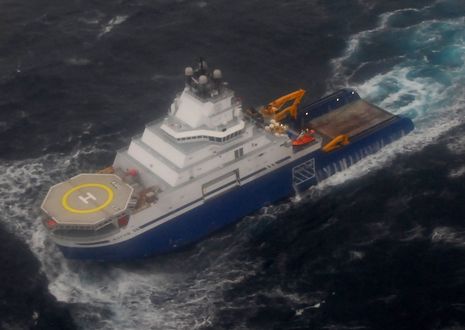
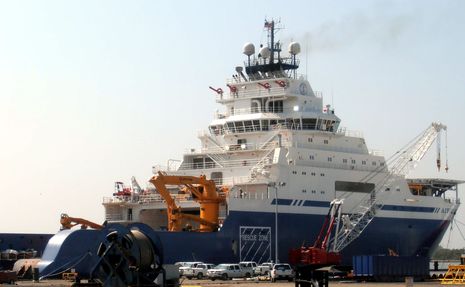
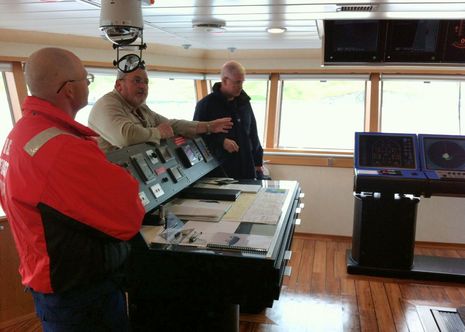
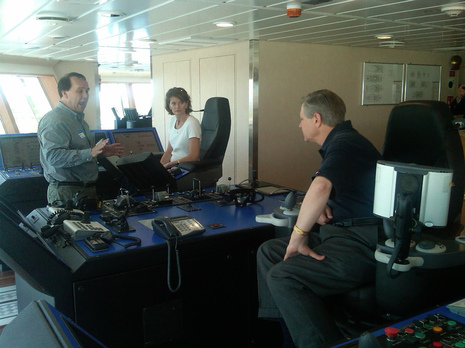
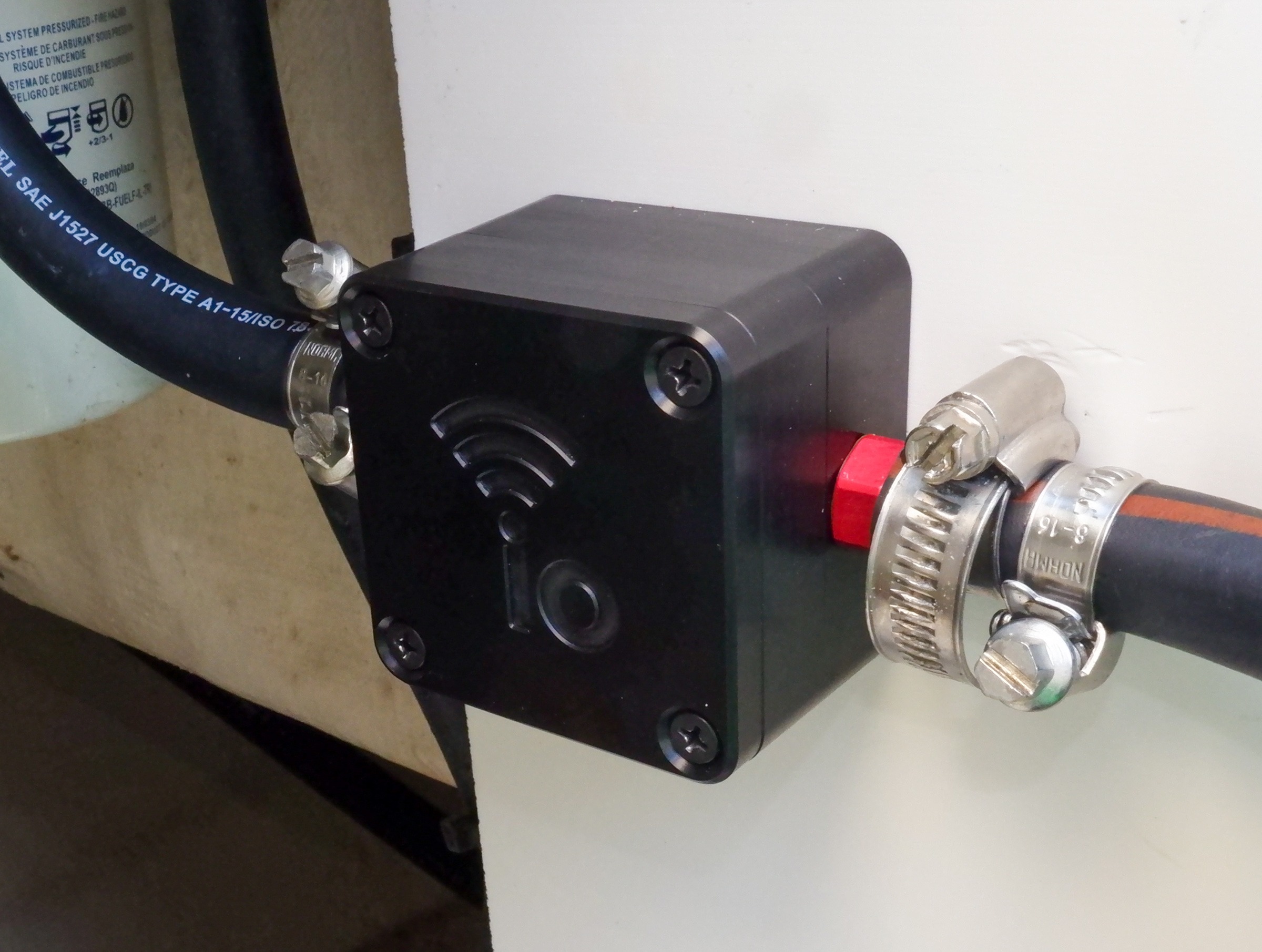









Understand that the “drill ship” Kulluk has no propulsion, not even dynamic positioning (which may not cut it in the far north ice anyway). I can’t find the size for the 12 anchors but the winches each have the capacity to handle 3,763 feet of 3.5-inch 573 ton breaking strength wire!
So try to imagine the Aiviq’s job of deploying those anchors in the Arctic. When I spent a few months in 1973 aboard a 180-foot supply boat off Texas we sometimes hosted anchor crews and it was hairy. The forces involved and the rig/boat/team coordination required were big time, and that was toy scale relative to what this boat does.
By the way, Aiviq is rated as able to run through one meter of ice and has “heeling pumps” to help, which I’d really like to understand.
There is lots of discussion about the incident and vessels in the gCaptain forums. Some folks seem to think that the Aiviq was rather large for the towing job. Stowage of all the anchor chain is one reason that might explain her size as is the variety of collateral duties she has beyond towing the rig.
Check out the diagrams of the ship called “Hull 247” which appears to be Aiviq.
http://www.boem.gov/uploadedFiles/BOEM/Oil_and_Gas_Energy_Program/Plans/Regional_Plans/Alaska_Exploration_Plans/2012_Shell_Beaufort_EP/Appendix%20K%20-%20Ice%20Management.pdf
Meanwhile, Shell Oil is still trying to perfect their oil spill containment equipment:
see “Sea Trial Leaves Shell’s Arctic Oil-Spill Gear “Crushed Like A Beer Can,”
http://www.kuow.org/post/sea-trial-leaves-shells-arctic-oil-spill-gear-crushed-beer-can
I saw from the diagrams that the tug has two bow thrusters. How does that work with the ice breaking. I would think that ice would get jammed up in the tunnel. It must be one stout bow thruster!
Actually Aiviq has three bow thrusters when you include the 2,000 kW fold-down with the two fixed 1,500 kW Brunvoll FU100 models. Plus two 1,050 kW stern thrusters and the four 5,444 bhp Cat C280-12 main engines running to “two 4,600-mm-diameter controllable-pitch propellers in nozzles via Flender twin-in/single-out gearboxes”!
I got all that from the Pro Mariner profile and, while I don’t entirely understand what it all means, it accounts in part for my fascination with this type of vessel. It may be huge, but it’s designed and equipped to noodle around other vessels and fixed objects as if it was much smaller.
I know zilch about working around ice, but that PDF linked to by Pat McQueen has quite a lot on the subject, particularly the nuances of protecting a drilling rig like Kulluck.
Too bad they didn’t build some redundancy into the fuel systems which should be absolutely bulletproof in a vessel like this.
Didn’t they lose all 4 engines at the same time?
We see this in the big cruise ships too,losing all electricity and having to be towed back to port.
Or a fire breaks out and they’ve put all the gensets in the same room.Two is one and one is none.
As for the Shell platform,it’s up on the rocks and ready to leak fuel all over the place.
Not ready for the Arctic.
I have / live on a 44′ sailboat and I have done a fair amount of off shore sailing on different boats. One thing I have found will ruin your trip quickly is bad fuel. I would think they would have all types of fuel filter redundancy, active polishing, etc. but who knows.
I built my own fuel polisher and would not take an unknown boat off shore without cleaning the fuel. It can take out multiple engines / generators quickly.
I would love to know how they lost all 4 engines at once…
It’s all about “single point” failure nodes. Diesel engines require fuel, air, and cranking power to operate. The ignition part is built in. It is not unusual for larger vessels to have a single large fuel line manifolded to multiple engines and a single large battery space (room) to provide cranking power or a single large compressor receiver to provide air for cranking. True redundancy requires separate systems to supply these things. In critical underground facilities even the combustion air supply may be separate for each engine.
Whatever redundancy you have is entirely dependent upon what level of need you require and how much you are willing to spend.
An interesting weather blog post on why they should have never attempted that tow in the first place:
http://tinyurl.com/a37q4dk
And it seems the real reason for the mid-winter tow was not the non-existent “weather window” but was tax avoidance:
http://tinyurl.com/a5t3fps
steve
Glad to see Aiviq pull Kulluk to a safer place.
http://gcaptain.com/tag/kulluk-grounding/
While not a fan of more laws and regulations, working in the high arctic, or antarctic, it would seem prudent for moving rigs like this with he capacity to pollute or damage the environment that they require 100% redundancy of tow vessels.
A second ship (or ships)equaling the line pulling capacity of the Aiviq would have prevented the tow getting away. It all came out good this time, but there will always be a next time.
Hi Ben,
Sorry for the delay in posting this but, yes, the bridge is certainly an interesting design and we posted a few photos of it on the gCaptain forum:
http://gcaptain.com/forum/professional-mariner-forum/9052-aiviq-photos.html
Two of the domes are likely CCom VSAT antennas (http://www.marine-technologies.com/vsat.html). On offshore vessels nearly every system is redundant which is why you’d have 2 vsat antennas. The other two are probably VSAT antennas as well because the client often installs his own equipment. So my guess (and this is just a guess) is that the 2 white antennas are CCOM and the 2 grey one’s are shell (HarrisCaprock.com supplies the communications equipment to most oil majors).
Another possibility is that two of the domes are doppler weather radars (the Doprad fury being the most ubiquitous doppler radar offshore: http://www.doprad.com/pdfs/fullbrochure.pdf)
Marine Technologies is an interesting company itself. Edison Chouest likes to do everything in house… so not only did they build, own and operate the Aiviq but the Chouest family also owns and operates MarineTechnologies LLC as well as other related companies like c-innovation, which builds and operates ROVs.
Also of note that this vessel has two bridge and a GMDSS communication station. The photo you posted with the USCG inspector (in the orange jacket) is the GMDSS console, the other photo (the one in which people are sitting down) is of the DP station which faces aft. Neither show the actual bridge of the ship….
(Here are the direct image links so you don’t have to log into the forum:
Bridge photo: http://gcaptain.com/images/LP2R8144.jpeg
Dp Station: http://gcaptain.com/images/LP2R8149.jpeg
-John
Thanks so much, John. Excellent info and great photos!
http://tinyurl.com/inquirer-USNavy-tubbataha-reef
Would be good to know what these guys have on their bridge!
Hi, I was looking for stuff about the Aiviq today and stumbled on this site, and it occurred to me that there must be many people with an interest in marine matters who have no idea what the controls of an offshore vessel look like, so by way of information I have added a photo of a Norwegian anchor-handler to my picture of the day. It can be found here:
http://www.shipsandoil.com/Picture%20of%20the%20Day%202013/2013PicoftheDay.html
Regards.
Icebreakers work by sliding the front on top of thick ice and sinking thru. Hence the leveling system.
Pretty bad that this happened.